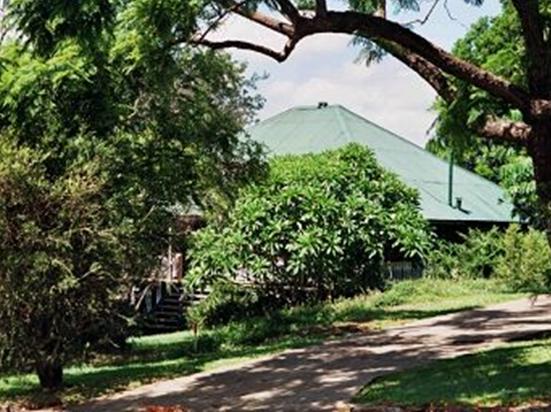Addresses
Type of place
House
Period
Victorian 1860-1890
Style
Queenslander
Addresses
Type of place
House
Period
Victorian 1860-1890
Style
Queenslander
This bungalow style timber and tin house was originally constructed in Darra circa 1889 and moved to this site in Hilda Street by bullock dray in 1899 after the land was purchased by Sarah and Alfred Midgley. Alfred worked in a wide range of fields; as a miner, an engineer, an auctioneer, a head clerk, a Member of the Legislative Assembly for Fassifern and Bulimba, and was also a published poet. Sarah helped to establish the Corinda Knitting Mills and, after Alfred’s death in 1930, began to produce dolls, which were popular among international collectors. The substantially intact house has remained in the Midgley family since the 1890s.
Also known as
Home on the Hill
Lot plan
L25_RP29566
Key dates
Local Heritage Place Since —
Date of Citation —
Construction
Roof: Corrugated iron;Walls: Timber
People/associations
the Midgley family (Occupant)Criterion for listing
(A) Historical; (H) Historical associationInteractive mapping
Also known as
Home on the Hill
Lot plan
L25_RP29566
Key dates
Local Heritage Place Since —
Date of Citation —
Construction
Roof: Corrugated iron;Walls: Timber
People/associations
the Midgley family (Occupant)Criterion for listing
(A) Historical; (H) Historical associationInteractive mapping
History
The area from Chelmer to Corinda was known as “Boyland’s Pocket” in the 1850s, Captain Boyland having leased the area in 1851. In 1860 the new Queensland government opened up the district for selection, at a price of 1 pound per acre, resulting in the establishment of a number of farms ranging anywhere between 25 and 70 acres in size. Attempts were made by pioneer selectors during the 1860s and 1870s to produce maize, potatoes, bananas, cotton, sugar cane, and arrowroot. The opening of a railway bridge at Indooroopilly in 1876 reduced the isolation of the area, and allowed for increased subdivision. The first main wave occurred in the 1880s, a boom period for Brisbane. However, many of the allotments sold at this time remained vacant for years, and continued to be used for small farming operations. Later waves of building, occurring after each of the World Wars, gradually reduced the amount of farmland, and new housing continues to envelop those gracious older houses which once stood on acreage, surrounded by gardens.
In the 1890s the Midgley family were living in a house called “Dalkeith” in Sherwood. Alfred Midgley is listed in postal records as an accountant living in Sherwood from 1893, and he appears to have been a jack-of-all trades. Born in Leeds, Yorkshire in 1849, and apprenticed to an engineer in the 1860s, Alfred became a Wesleyan Methodist preacher in the late 1860s. After arriving in Brisbane in the Storm King in 1870, he worked as an engineer in Rockhampton, and later as a miner in Ipswich, Toowoomba and Brisbane during the 1870s. He was a produce merchant in Brisbane between 1879 and 1887, and also an auctioneer. Around this time, Midgely sold his house at Sandgate and moved to Taringa, becoming a head clerk for a leading merchant. Alfred, a published poet, was also an MLA for Fassifern between 1883 and 1887, and for Bulimba in 1899.
The Midgleys had lived in a small house in Sherwood whilst saving to buy a larger property. In June 1899 Alfred’s second wife (married 1886), Sarah Ellen Midgley, purchased 1 rood of land in Corinda from Alfred Henry Brown, purchasing the neighbouring rood (four acres) in December of that year. The present house stands on the latter land purchase. Apparently, a ten-year old house was purchased in Darra by the Midgleys, and moved by bullock team onto the Hilda St site in 1899.
As Labour party supporters the family earned the disapproval of their middle-class neighbours, and Alfred’s opposition to the Boer War led some to question the loyalty of the Midgleys, according to a family biography written by Alfred’s daughter, Zoe O’Leary.
Alfred died in 1930, and Sarah in 1954. The house was transferred to three of their daughters in 1955, then into the name of one of them in 1956, Marguerite Victoria Burnett. Her daughter, Zoe Burnett, has owned the house since 1964. A post-war house (42 Hilda St) now stands on half of the property.
Statement of significance
Relevant assessment criteria
This is a place of local heritage significance and meets one or more of the local heritage criteria under the Heritage planning scheme policy of the Brisbane City Plan 2014. It is significant because:
References
-
Title deeds, Department of Natural Resources and Mines
-
Walter Taylor South Character and Heritage Study, BCC Heritage Unit, 1997
-
Queensland Post Office Directories
-
Them’s Our Ways in Oxley-Chelmer, Ralph Fones, 1995
-
Biographical Register of the Queensland Parliament, 1860-1929
-
D.B. Waterson, ANU Press, Canberra, 1972
-
The Little Byron, Zoe O’Leary, 1982
-
Brisbane City Council Water Supply and Sewerage Detail Plans
-
McKellar's Map of Brisbane and Suburbs. Brisbane: Surveyor-General’s Office, 1895
-
Queensland Pioneers Index 1829-1889. Births, Deaths and Marriages
-
Dictionary of Australian Artists Online: http://www.daao.org.au/main/read/4464
Citation prepared by — Brisbane City Council (page revised June 2022)

